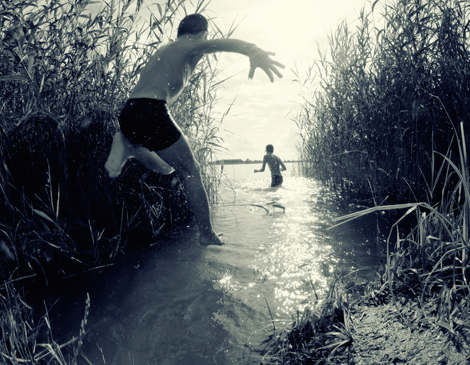The fourth song on R.E.M.’s 1986 album Life’s Rich Pageant, “Cuyahoga” begins with a haunting bass line, evoking a quiet current pulling us forward, wondering what is missing, what we can’t see. On an album of joyous major-chord anthems, this one feels elegiac, shadowed by minor chords.
I’d been puzzling over R.E.M.’s lyrics ever since I first heard them in the mid-’80s, when they started getting major radio airplay. You could hear the lyrics enough times to almost sing along. But “Cuyahoga” announced itself with surprising clarity. “Let’s put our heads together,” Michael Stipe sings, “And start a new country up / Our father’s father’s father’s tribe / Erased the parts he didn’t like / Let’s try to fill it in.”
Seventeen years before “Cuyahoga,” the river burned and appeared in Time magazine, becoming a symbol of reckless corporate pollution. But in Chicago, and in Cleveland with its Cuyahoga, only the words of the natives were left.
In “Cuyahoga” Stipe moves beyond a typical protest about abuse of the environment into one that tries to reimagine the whole project of America. In those first lines, Stipe delivers a brief history of American colonial expansion and erasure of the indigenous people, and invites us to go back and reclaim what we (those of us who came from elsewhere) could never own.
The verse takes a snapshot of kids swimming in a river, and invites us in: “This is where we walked / This is where we swam.” Who is this “we,” this “we” who skin knees, and the river runs red? They could be Clevelanders in the 1960s or the Mohawk in the 1760s. Is Stipe giving voice to the lost natives, or showing how every child playing imagines those who were once here? Their youthful play is beautiful and innocent, yet troublingly familiar — the way kids play cowboys and Indians on the very land where people fought and perished and were erased.
So many years ago, I had never seen this river, but, relishing that song, I had heard its truth. I’d had my own rivers and creeks in the suburbs of Chicago, so I didn’t need to know the Cuyahoga. But fate took me here nearly two decades ago, and every time my wife Amy and I saw a sign that said “Cuyahoga,” we’d break out into song.
Late last summer, nearly 50 years after that infamous burning, I rowed along with others in a dragon boat along the Cuyahoga. It was terribly hot, as if the air itself were on fire. The industrial signature of bridges and metal and concrete bulwarks still lingered, yet the river smelled clean. As my fellow dragon-boaters and I dug our oars, splashing water over each other, our shorts got soaked, a relief from the heat.
The guide pointed out new gardens of native plants growing alongside the river, between us and the buildings with smashed windows and graffitied exteriors. She pointed out the place beneath a highway bridge where hawks were roosting. On a concrete bulwark, two blue herons engaged in courting, the male fluffing his feathers and wings, showing his neck’s graceful stretch.
At the bridge of R.E.M.’s track, it turns away from the dreamy imaginings of a “we” where there is no difference between settler and native. Stipe sings, and the song points its finger at all of us, the “we” who welded the bridges and poured the bulwarks: “Let’s put our heads together / And start a new country up / Up underneath the riverbed / We’ll burn the river down.”
When the song returns to the verse, things have turned darker. The pronouns become accusatory and pointed, the “we” divorced from the “they.” “This is where they walked, swam / Hunted, danced and sang.” Then the song retells history:
“Rewrite the book and rule the pages /
Saving face, secured in faith /
Bury, burn the waste behind you /
This land is the land of ours.”
Of course, the forefathers of this country ruled the pages of the past, expelling the natives, asphalting the rivers and creating Chief Wahoos. It’s a cliche to say that history is written by the victors, but Stipe goes farther, and imagines a book where the victor’s rulings aren’t final, where the facts of their actions remain in another book where they won’t be forgotten.
Every day, I walk to work in University Heights, looking at the land around me, occasionally catching glimpses of vestiges of what once were apple orchards. Who once walked here, hunted, danced and sang? When the road cracks after winter, I see the brick road beneath the asphalt. What’s underneath that? And the water that seethes from broken sewer pipes like human rivers, what’s beneath that?
Though the Cuyahoga River is cleaner, its banks full of herons and flowers, I wonder where all of us are heading. At the end of each refrain, I realize only now, Stipe sings, “Cuyahoga, gone.”
If we put our heads together, could we slow this hurtling, this heating-up, this planetary burning?




